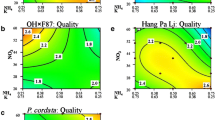Abstract
The influence of nitrogen on growth and morphogenesis of tissue cultures has been well established. Availability of nitrogen and the form in which it is presented are of great importance. Nitrate has generally been considered to be the most essential form of nitrogen for the culture of tissues. However in many cases culturing tissues on nitrate alone as a source of nitrogen has not been very successful [9, 15, 16]. It has been found that a reduced nitrogen source such as ammonium is essential for the optimal use of nitrate ion by tissue cultures. A number of studies have shown that growth of tissue cultures is possible on a medium containing ammonium as the sole nitrogen source provided that a Kreb’s cycle dicarboxylic acid is also present in the medium [7]. Tobacco cells were found capable of growing on ammonium alone, provided citrate, malate and pyruvate were added to the culture medium [3, 6]. Later Dougall and Verma [4] demonstrated that suspension cultures of wild-carrot could be grown with ammonium as a sole nitrogen source even in the absence of any exogenous Kreb’s cycle acid. However a combination of nitrate and ammonium is still considered to be an ideal source of nitrogen for tissue cultures [10, 15]. George and Sherrington [8] suggest that as most tissue culture media have not been buffered, the concentration of ammonium and nitrate ions have probably been adopted more to obtain practical pH control than because of the requirement of plant tissues for one form of nitrogen or another. Uptake of ammonium and nitrate forms of nitrogen has been reported to be correlated with the pH of the medium. Uptake of nitrate requires an acid pH, but the medium drifts towards alkalinity [1]. In contrast, ammonium uptake shifts the medium pH towards acidity [4, 5, 7, 18] and consequently further uptake of ammonium is inhibited. Therefore it is evident that in an unbuffered medium efficient nitrogen uptake depends on the presence of both ions. Most of the studies on the effects of different nitrogen forms and related pH factors have been concentrated on cell culture and embryogenesis studies using unbuffered media. No definitive studies regarding these factors have been reported as far as in vitro rooting is concerned. Hence this study was undertaken to investigate the effect of sources of nitrogen and associated pH changes on in vitro rooting.
Access this chapter
Tax calculation will be finalised at checkout
Purchases are for personal use only
Preview
Unable to display preview. Download preview PDF.
Similar content being viewed by others
References
Bayely JM, King J and Gamborg OL (1972) The ability of amino compounds and conditioned medium to alleviate the reduced nitrogen requirements of soybean cells grown in suspension cultures. Planta 105:25–31
Beevers L and Hageman RH (1980) Nitrate and nitrate reduction. In: PK Stumpf and EE Conn,eds. The Biochemistry of plants, vol.5, Amino Acids and Derivatives, ed. BJ Miflin, pp 115–168. New York: Academic press
Behrend J and Mateles RI (1975) Nitrogen metabolism in plant cell suspension cultures. II.Role of organic acids during growth on ammonia. Plant Physiol 58:510–512
Dougall DK and Verma DC (1978) Growth and embryo formation in wild carrot suspensioncultures with ammonium ion as a sole nitrogen source. In Vitro 14:180–182
Fowler MW, Watson R and Lyons I (1982) Substrate utilization, carbon and nitrogen, by suspension cultured plant cells pp. 225–228. In proceedings of 5th congress of Plant Tissue and Cell culture ed. Fujiwara A, The Japanese Association for Plant Tissue Culture, Tokyo
Gamborg OL (1970) The effects of amino acids and ammonium on the growth of plant cells in suspension culture. Plant Physiol 45:372–375
Gamborg OL and Shyluk JP (1970). The culture of plant cells with ammonium salts as the solenitrogen source. Plant Physiol 45:598–600
George EF and Sherrington PD (1984) Plant Propagation by Tissue Culture. Hants, England: Exegetics Ltd
Halperin W and Wetherell DF (1965) Ammonium requirement for embryogenesis in vitro. Nature 295:519–520
Kirby EG, Leustek T and Lee MS (1987) Nitrogen nutrition. In: JM Bonga and DJ Durzan, eds. Cell and Tissue Culture in Forestry I. General Principles and Biotechnology, pp. 67–88.Dordrecht: Martinus Nijhoff
Martin SM and Rose D (1976) Growth of plant cells (Ipomoea) suspension cultures at controlled pH levels. Can J Bot 54:1264–1270
Murashige T and Skoog F (1962) A revised medium for rapid growth and bioassays with tobacco tissue cultures. Physiol Plant 15:473–497
Rahman MA and Blake J (1988) The effects of medium composition and culture conditions on in vitro rooting and ex vitro establishment of jackfruit (Artocarpus heterophyllus Lam.). Plant Cell Tiss Org Cult 13:189–200
Sathyanarayana BN and Blake J (Unpublished)
Selby C and Harvey BMR (1990) The influence of composition of the basal medium on the growth and morphogenesis of sitka spruce (Picea sitchensis) tissues. Ann Bot 65:395–407
Smith DL and Krikorian AD (1990) pH control of carrot somatic embryogenesis. In: HJJ Nijkamp, LHW Van Der Plas and J Van Aartrijk, eds. Progress in Plant Cellular and Molecular Biology. Proceedings of the Vllth International Congress on Plant Tissue and Cell culture, 449–453. Dordrecht: Kluwer Academic Publishers
Standardi A and Fausto R (1990) Effects of some antioxidants on in vitro rooting of appleshoots. Hort Sci 25:1435–1436
Wetherell DF and Dougall DK (1976) Sources of nitrogen on growth and embryogenesis incultured wild carrot tissue. Physiol Plant 37:97–103
Author information
Authors and Affiliations
Editor information
Rights and permissions
Copyright information
© 1994 Springer Science+Business Media Dordrecht
About this chapter
Cite this chapter
Sathyanarayana, B.N., Blake, J. (1994). The effect of nitrogen sources and initial pH of the media with or without buffer on in vitro rooting of jackfruit (Artocarpus heterophyllus Lam.). In: Lumsden, P.J., Nicholas, J.R., Davies, W.J. (eds) Physiology, Growth and Development of Plants in Culture. Springer, Dordrecht. https://doi.org/10.1007/978-94-011-0790-7_8
Download citation
DOI: https://doi.org/10.1007/978-94-011-0790-7_8
Publisher Name: Springer, Dordrecht
Print ISBN: 978-94-010-4339-7
Online ISBN: 978-94-011-0790-7
eBook Packages: Springer Book Archive




